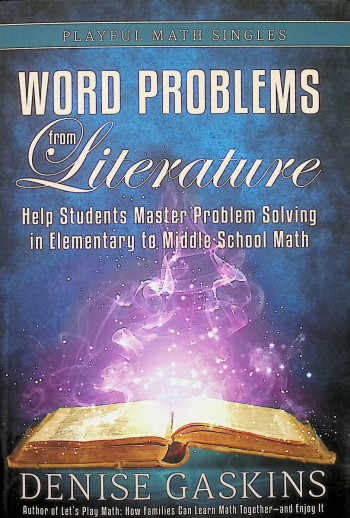We use cookies to make your experience better. To comply with the new e-Privacy directive, we need to ask for your consent to set the cookies. Learn more.
Word Problems from Literature: Help Students Master Problem Solving in Elementary to Middle School Math
Word problems are difficult for many students because they don't understand what the question is really asking. Word Problems From Literature teaches students how to decipher each question and make sense of the problem. Using information from Mr. Popper's Penguins, Ben Franklin, Narnia, The Hobbit, and Lord of the Rings, students learn how to work problems using bar model diagrams as a visual manipulative. One-step and multi-step problems using multiplication, fractions, ratios, and algebra become a breeze when students learn how to apply the logical formula presented in this program.
The text for this series offers the reading content, and bar model diagrams illustrate the concept of the problem. A simple example is, "Mr. Popper had 78 fish. The penguins ate 40 of them. How many fish did Mr. Popper have left?" Bar modeling is explained in the front of the text and the workbook. Students learn two rules: The whole is the sum of its parts, and simplify to a single unknown. The information in the text explains in a very step-by-step fashion the process for solving. The questions posed in the text offer practice for the bar-modeling process to make solving word problems easier. The text includes answers to the problems. 100 pgs. Pb.
You can prevent math anxietyby giving your children the mental tools they need to conquer the toughest story problems.
Young children expect to look at a word problem and instantly see the answer. But as they get older, their textbook math problems also grow in difficulty, so this solution-by-intuitive-leap becomes impossible. Too often the frustrated child concludes, Im just not good at math.
But with guided practice, any student can learn to master word problems.
Word Problems from Literaturefeatures math puzzles for elementary and middle school students from classic books such asMr. Popper's PenguinsandThe Hobbit.Denise Gaskins demonstrates step by step how to use the problem-solving tool of bar model diagrams, a type of pictorial algebra. For children who are used to playing with Legos or other blocksor with computer games like Minecraftthis approach reveals the underlying structure of a math word problem. Students can make sense of how each quantity in the story relates to the others and see a path to the solution.
And when you finish the puzzles in this book, Denise shows you how to create your own word problems from literature, based in your childrens favorite story worlds.
Word problems are difficult for many students because they don't understand what the question is really asking. Word Problems From Literature teaches students how to decipher each question and make sense of the problem. Using information from Mr. Popper's Penguins, Ben Franklin, Narnia, The Hobbit, and Lord of the Rings, students learn how to work problems using bar model diagrams as a visual manipulative. One-step and multi-step problems using multiplication, fractions, ratios, and algebra become a breeze when students learn how to apply the logical formula presented in this program.
The text for this series offers the reading content, and bar model diagrams illustrate the concept of the problem. A simple example is, "Mr. Popper had 78 fish. The penguins ate 40 of them. How many fish did Mr. Popper have left?" Bar modeling is explained in the front of the text and the workbook. Students learn two rules: The whole is the sum of its parts, and simplify to a single unknown. The information in the text explains in a very step-by-step fashion the process for solving. The questions posed in the text offer practice for the bar-modeling process to make solving word problems easier. The text includes answers to the problems. 100 pgs. Pb.
The Student Workbook is a companion to the text and provides space for the student to do the problems. The same word problems are printed in the workbook as in the text, but the workbook offers plenty of space for drawing models and solving the problems. Students could do these same problems on their own paper, but the workbook provides an organized space in which to work. 80 pgs. Pb.
The fact that this course uses literature might have some appeal for those who appreciate the Charlotte Mason approach to education, but the thorough and logical explanations make it a nice companion to any math curriculum. ~ Donna
| Product Format: | Paperback |
|---|---|
| Brand: | TableTop Academy Press |
| Author: | Gaskins |
| Grades: | PK-AD |
| ISBN: | 9781892083647 |
| Length in Inches: | 9 |
| Width in Inches: | 6 |
| Height in Inches: | 0.3125 |
| Weight in Pounds: | 0.4 |

